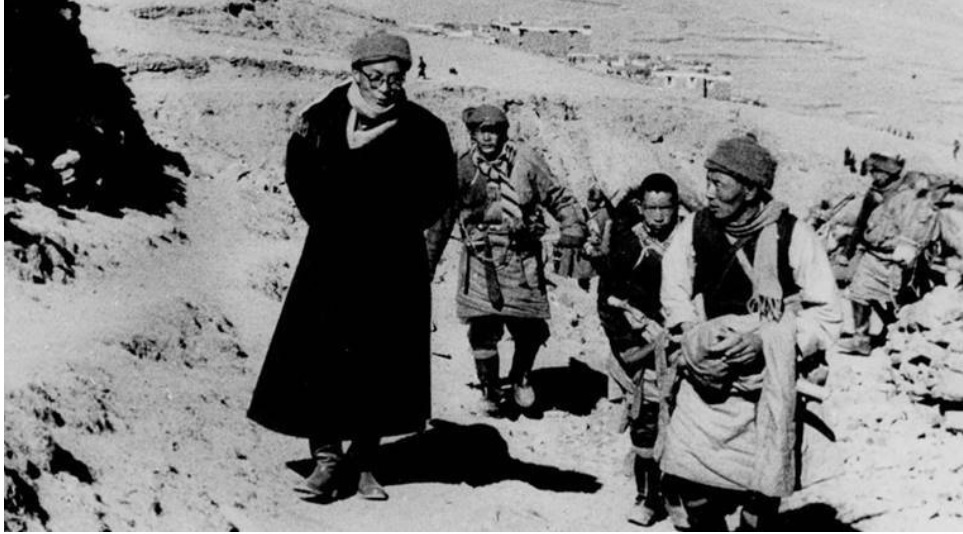Why does the Dalai Lama Live in India? I don’t know how many of you know the answer.
Today on 23 May 2023, Bollywood actress Preity Zinta and her husband Gene Goodenough met Dalai Lama in Dharmashala after the hectic schedule of IPL (as they say).
This reminded me of the spiritual leader who escaped Tibet long back to seek refuge in India. He says that wherever he is in Tawang Monastery, Arunachal Pradesh he gets emotional because this is where he enjoyed freedom for the first time.

Table of Contents
It was on March 17, 1959, when Dalai Lama dressed up as a soldier slipped out of the monastery along with 20 others who accompanied him.
In 1960, he set up his government-in-exile in Dharamshala, a former British Hill Station in Himachal Pradesh, where he continues to reside.
He, as the spiritual leader of Tibetan Buddhism, has been living in India for several decades. His decision to seek refuge in India was a significant turning point in both his life and the political landscape of Tibet.
This article explores the reasons behind his choice to reside in India and the implications it has had on Tibetan culture, spirituality, and the relationship between India and Tibet.
The Chinese Occupation
To understand why the Dalai Lama lives in India, we must first delve into the historical context. In 1950, the People’s Republic of China invaded Tibet, claiming it as part of its territory.
This invasion sparked a period of immense turmoil for Tibetans, as the Chinese government sought to exert control over the region and suppress Tibetan Buddhism and culture.
The Dalai Lama, then a young spiritual leader at the age of 15, was thrust into a position of responsibility and had to make a choice that would shape the course of his life.
Escape to India
Faced with the escalating repression and violence in Tibet, he made the difficult decision to flee his homeland (Lhasa) in 1959.
Accompanied by a group of loyal followers, he embarked on a perilous journey across the treacherous Himalayas, eventually reaching the Indian border.
The Indian government, recognizing the dire situation and the importance of preserving Tibetan culture, welcomed him and provided him with political asylum.
Preserving Tibetan Culture
One of the primary reasons he chose India as his new home was the country’s long-standing commitment to religious and cultural diversity.
India, with its rich history of spiritual traditions, offered a conducive environment for him to continue his religious teachings and preserve Tibetan culture.
By living in India, he has been able to establish Tibetan Buddhist monasteries, schools, and cultural institutions that serve as important centers of learning and practice.
Spiritual and Intellectual Freedom
In addition to preserving Tibetan culture, his residence in India has provided him with the freedom to propagate his spiritual teachings without interference.
In contrast to the restrictions imposed by the Chinese government in Tibet, he has been able to travel internationally and engage with people from all walks of life.
His teachings on compassion, mindfulness, and interfaith harmony have resonated with audiences worldwide, fostering a global appreciation for Tibetan Buddhism and the principles of peace and nonviolence.
The Tibetan Government-in-Exile
India’s support for the Tibetan cause is evident in its recognition of the Tibetan Government-in-Exile, also known as the Central Tibetan Administration (CTA), headquartered in Dharamshala, Himachal Pradesh.
The CTA serves as the political and administrative body representing Tibetans outside of Tibet. Its establishment in India has allowed the Tibetan diaspora to maintain a semblance of governance, ensuring the continuity of the Tibetan struggle for autonomy and the preservation of their unique identity.
Political Implications
The Dalai Lama’s presence in India has also had significant political implications. China has viewed him as a separatist, often accusing him of attempting to split Tibet from China.
However, he has consistently advocated for a “middle way” approach, seeking meaningful autonomy for Tibet within the framework of the Chinese constitution.
Despite these efforts to find a peaceful resolution, tensions between China and the Dalai Lama remain.
India’s Relationship with China
The Dalai Lama’s residence in India has occasionally strained India’s relationship with China. The Chinese government views India’s sheltering of the Dalai Lama as interference in its internal affairs and has repeatedly exerted pressure on India to curtail the Dalai Lama’s activities.
Nevertheless, India has maintained its position, asserting the Dalai Lama’s right to religious freedom and political asylum.
People-to-People Connection
Beyond politics, the Dalai Lama’s presence in India has fostered a deep people-to-people connection between the Indian and Tibetan communities. Indians have embraced Tibetan refugees, offering them support and assistance in various forms.
The Tibetan diaspora has contributed to the cultural and economic fabric of India, enriching it with its vibrant traditions and entrepreneurial spirit.
Conclusion On Why Does the Dalai Lama Live in India
The Dalai Lama’s decision to live in India has had profound implications for both Tibetan Buddhism and the geopolitical landscape of the region. His presence in India has provided a sanctuary for Tibetan culture and spirituality, allowing it to flourish in exile.
Furthermore, it has strengthened the bond between India and Tibet, creating a platform for dialogue, cultural exchange, and the pursuit of mutual understanding.
As the Dalai Lama continues to reside in India, his teachings of compassion, peace, and interfaith harmony resonate far beyond the borders of the two nations, inspiring individuals around the world to seek a better future based on understanding and respect.
FAQs
Who is the Dalai Lama?
He is the spiritual leader of Tibetan Buddhism.
Where is the Dalai Lama from?
He is originally from Tibet.
Why did the Dalai Lama come to India?
The Dalai Lama came to India in 1959 following a failed uprising against Chinese rule in Tibet.
Where does the Dalai Lama live in India?
He resides in Dharamshala, in the state of Himachal Pradesh, India.
Does the Dalai Lama have political authority in India?
No, he does not hold any political authority in India. He is primarily a religious and spiritual leader.
How is the Dalai Lama received in India?
He is widely respected and revered in India. He has been welcomed and supported by the Indian government and people for several decades.
What activities does the Dalai Lama engage in while in India?
He engages in various religious, cultural, and educational activities. He gives teachings, conducts spiritual ceremonies, promotes interfaith dialogue, and works on preserving Tibetan culture and traditions.
Does the Dalai Lama travel outside of India?
Yes, he travels internationally to meet with followers, give teachings, and promote peace and compassion.
Is the Dalai Lama involved in political activities?
He has advocated for the welfare of the Tibetan people and their struggle for autonomy, but he has consistently emphasized a peaceful approach and has stepped away from any formal political role.
How long has the Dalai Lama been in India?
He has been in India since 1959, which makes it over six decades.
Is the Dalai Lama a Nobel Peace Prize laureate?
Yes, the 14th Dalai Lama, Tenzin Gyatso, was awarded the Nobel Peace Prize in 1989 for his nonviolent struggle for the liberation of Tibet and his efforts to promote peace globally.
Is the Dalai Lama considered a political refugee?
Yes, he is considered a political refugee as he fled Tibet and sought asylum in India following the Chinese occupation.



